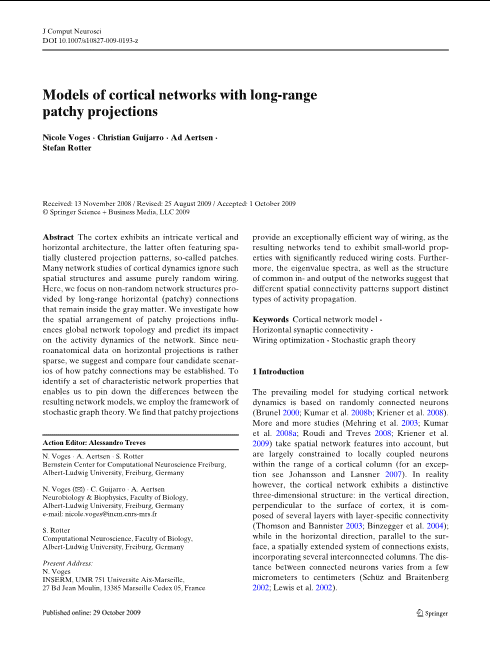
Welcome!
To use the personalized features of this site, please log
in or register.
If you have forgotten your username or password, we can help.
|
 |
Models of cortical networks with long-range patchy projections
| |
 |
Models of cortical
networks with long-range patchy projections
Nicole Voges1, 2, 4  ,
Christian Guijarro2, Ad Aertsen1, 2 and
Stefan Rotter1, 3 ,
Christian Guijarro2, Ad Aertsen1, 2 and
Stefan Rotter1, 3
| (1) |
Bernstein Center for
Computational Neuroscience Freiburg, Albert-Ludwig University, Freiburg,
Germany |
| (2) |
Neurobiology &
Biophysics, Faculty of Biology, Albert-Ludwig University, Freiburg,
Germany |
| (3) |
Computational Neuroscience,
Faculty of Biology, Albert-Ludwig University, Freiburg, Germany |
| (4) |
Present address: INSERM,
UMR 751 Universite Aix-Marseille, 27 Bd Jean Moulin,
13385 Marseille Cedex 05, France |
Received: 13 November 2008 Revised:
25 August 2009 Accepted: 1 October 2009 Published
online: 29 October 2009
Action Editor: Alessandro Treves
Abstract The cortex exhibits
an intricate vertical and horizontal architecture, the latter often
featuring spatially clustered projection
patterns, so-called patches. Many network studies of cortical
dynamics ignore such spatial structures and assume purely random
wiring. Here, we focus on non-random network structures
provided by long-range horizontal (patchy) connections that remain
inside the gray matter. We investigate how the spatial
arrangement of patchy projections influences global network topology
and predict its impact on the activity dynamics of the network.
Since neuroanatomical data on horizontal projections is rather
sparse, we suggest and compare four candidate scenarios of how
patchy connections may be established. To identify a set of
characteristic network properties that enables us to pin down
the differences between the resulting network models, we employ
the framework of stochastic graph theory. We find that patchy
projections provide an exceptionally efficient way of wiring,
as the resulting networks tend to exhibit small-world
properties with significantly reduced wiring costs. Furthermore, the
eigenvalue spectra, as well as the structure of common in- and
output of the networks suggest that different spatial connectivity
patterns support distinct types of activity propagation.
Keywords Cortical
network model - Horizontal synaptic
connectivity - Wiring optimization - Stochastic
graph theory
Fulltext Preview (Small, Large)
 References secured to subscribers.
|
|
|
|
|
|